Java进阶知识12 Hibernate多对多双向关联(Annotation+XML实现)
1、Annotation 注解版
1.1、应用场景(Student-Teacher):当学生知道有哪些老师教,老师也知道自己教哪些学生时,可用双向关联
1.2、创建Teacher类和Student类
package com.shore.model; import java.util.HashSet;
import java.util.Set; import javax.persistence.Entity;
import javax.persistence.GeneratedValue;
import javax.persistence.GenerationType;
import javax.persistence.Id;
import javax.persistence.ManyToMany;
import javax.persistence.Table; /**
* @author DSHORE/2019-9-22
* 多对多,双向关联(注解版)
*/
@Entity
@Table(name="anno_teacher")
public class Teacher {
private Integer id;
private String name;
private Integer age;
private Set<Student> students = new HashSet<Student>(); @Id
@GeneratedValue(strategy=GenerationType.IDENTITY)
public Integer getId() {
return id;
}
public void setId(Integer id) {
this.id = id;
}
public String getName() {
return name;
}
public void setName(String name) {
this.name = name;
}
public Integer getAge() {
return age;
}
public void setAge(Integer age) {
this.age = age;
} @ManyToMany(mappedBy="teachers") //和单向的多对多,只多了这一步。 只要是双向关联,必须加上这句话:(mappedBy="xxxxxx")
public Set<Student> getStudents() {
return students;
}
public void setStudents(Set<Student> students) {
this.students = students;
}
}
Student类
package com.shore.model; import java.util.HashSet;
import java.util.Set; import javax.persistence.Entity;
import javax.persistence.GeneratedValue;
import javax.persistence.GenerationType;
import javax.persistence.Id;
import javax.persistence.JoinColumn;
import javax.persistence.JoinTable;
import javax.persistence.ManyToMany;
import javax.persistence.Table; /**
* @author DSHORE/2019-9-22
* 多对一,双向关联(注解版)
*/
@Entity
@Table(name="anno_student")
public class Student {
private Integer id;
private String number;
private Float sum;
private Set<Teacher> teachers = new HashSet<Teacher>(); @Id
@GeneratedValue(strategy=GenerationType.IDENTITY)
public Integer getId() {
return id;
}
public void setId(Integer id) {
this.id = id;
}
public String getNumber() {
return number;
}
public void setNumber(String number) {
this.number = number;
}
public Float getSum() {
return sum;
}
public void setSum(Float sum) {
this.sum = sum;
} /**
* name:中间表的表名
* joinColumns:当前对象所对应的id
* inverseJoinColumns:对方对象所对应的id
*/
@ManyToMany
@JoinTable(name="anno_student_teacher",
joinColumns=@JoinColumn(name="student_id"),
inverseJoinColumns=@JoinColumn(name="teacher_id"))
public Set<Teacher> getTeachers() {
return teachers;
}
public void setTeachers(Set<Teacher> teachers) {
this.teachers = teachers;
}
}
1.3、创建hibernate.cfg.xml核心配置文件
<?xml version='1.0' encoding='utf-8'?>
<!DOCTYPE hibernate-configuration PUBLIC
"-//Hibernate/Hibernate Configuration DTD 3.0//EN"
"http://www.hibernate.org/dtd/hibernate-configuration-3.0.dtd"> <hibernate-configuration>
<session-factory>
<!-- Database connection settings -->
<property name="connection.driver_class">com.mysql.jdbc.Driver</property>
<property name="connection.url">jdbc:mysql://localhost:3306/hibernate</property>
<property name="connection.username">root</property>
<property name="connection.password">123456</property> <property name="dialect">org.hibernate.dialect.MySQLDialect</property>
<property name="cache.provider_class">org.hibernate.cache.NoCacheProvider</property>
<property name="show_sql">true</property>
<property name="hbm2ddl.auto">create</property> <mapping class="com.shore.model.Teacher" />
<mapping class="com.shore.model.Student" />
</session-factory>
</hibernate-configuration>
1.4、开始测试
package com.shore.test; import org.hibernate.cfg.AnnotationConfiguration;
import org.hibernate.tool.hbm2ddl.SchemaExport;
import org.junit.Test; /**
* @author DSHORE/2019-9-22
*
*/
public class AnnotationTest {
@Test
public void test() {//简单测试,只创建表,不插入数据
//注解版,这里用AnnotationConfiguration()方法。
new SchemaExport(new AnnotationConfiguration().configure()).create(
false, true);
}
}
测试结果图:

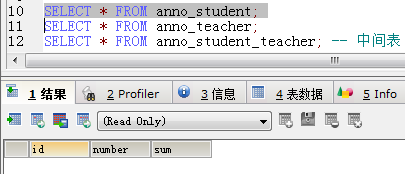
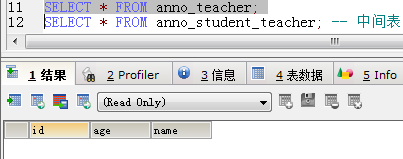
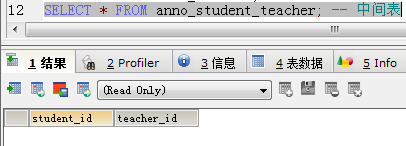

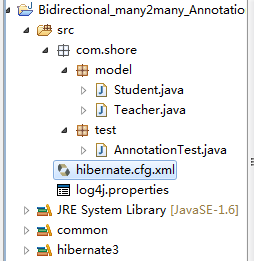 表结构虽然看起来和单向多对多关联的没什么区别,但进行CRUD操作时,就会发现他们的区别了,此处不做解析
表结构虽然看起来和单向多对多关联的没什么区别,但进行CRUD操作时,就会发现他们的区别了,此处不做解析
2、XML版 的实现
2.1、创建Teacher类和Student类
package com.shore.model; import java.util.HashSet;
import java.util.Set; /**
* @author DSHORE/2019-9-22
* 多对多,双向关联(xml版)
*/
public class Teacher {
private Integer id;
private String name;
private Integer age;
private Set<Student> students = new HashSet<Student>(); public Integer getId() {
return id;
}
public void setId(Integer id) {
this.id = id;
}
public String getName() {
return name;
}
public void setName(String name) {
this.name = name;
}
public Integer getAge() {
return age;
}
public void setAge(Integer age) {
this.age = age;
}
public Set<Student> getStudents() {
return students;
}
public void setStudents(Set<Student> students) {
this.students = students;
}
}
Student类
package com.shore.model; import java.util.HashSet;
import java.util.Set; /**
* @author DSHORE/2019-9-22
* 多对多,双向关联(xml版)
*/
public class Student {
private Integer id;
private String number;
private Float sum;
private Set<Teacher> teachers = new HashSet<Teacher>(); public Integer getId() {
return id;
}
public void setId(Integer id) {
this.id = id;
}
public String getNumber() {
return number;
}
public void setNumber(String number) {
this.number = number;
}
public Float getSum() {
return sum;
}
public void setSum(Float sum) {
this.sum = sum;
}
public Set<Teacher> getTeachers() {
return teachers;
}
public void setTeachers(Set<Teacher> teachers) {
this.teachers = teachers;
}
}
2.2、创建 Teacher.hbm.xml 配置文件和 Student.hbm.xml 配置文件
<?xml version="1.0"?>
<!DOCTYPE hibernate-mapping PUBLIC
"-//Hibernate/Hibernate Mapping DTD 3.0//EN"
"http://www.hibernate.org/dtd/hibernate-mapping-3.0.dtd"> <hibernate-mapping package="com.shore.model">
<class name="Teacher" table="xml_teacher">
<id name="id">
<generator class="native"/>
</id>
<property name="name" type="java.lang.String"/>
<property name="age" type="java.lang.Integer"/> <!-- 多对多 双向关联 -->
<set name="students" table="xml_student_teacher">
<key column="teacher_id"/> <!-- 当前对象所对应的id -->
<many-to-many class="com.shore.model.Student" column="student_id"/> <!-- 对方对象所对应的id -->
</set>
</class>
</hibernate-mapping>
Student.hbm.xml 配置文件
<?xml version="1.0"?>
<!DOCTYPE hibernate-mapping PUBLIC
"-//Hibernate/Hibernate Mapping DTD 3.0//EN"
"http://www.hibernate.org/dtd/hibernate-mapping-3.0.dtd"> <hibernate-mapping package="com.shore.model">
<class name="Student" table="xml_student">
<id name="id">
<generator class="native"/>
</id>
<property name="number" type="java.lang.String"/>
<property name="sum" type="java.lang.Float"/> <!-- 多对多 双向关联 -->
<set name="teachers" table="xml_student_teacher">
<key column="student_id"/> <!-- 当前对象所对应的id -->
<many-to-many class="com.shore.model.Teacher" column="teacher_id"/> <!-- 对方对象所对应的id -->
</set>
</class>
</hibernate-mapping>
2.3、创建hibernate.cfg.xml 核心配置文件
<?xml version='1.0' encoding='utf-8'?>
<!DOCTYPE hibernate-configuration PUBLIC
"-//Hibernate/Hibernate Configuration DTD 3.0//EN"
"http://www.hibernate.org/dtd/hibernate-configuration-3.0.dtd"> <hibernate-configuration>
<session-factory>
<!-- Database connection settings -->
<property name="connection.driver_class">com.mysql.jdbc.Driver</property>
<property name="connection.url">jdbc:mysql://localhost:3306/hibernate</property>
<property name="connection.username">root</property>
<property name="connection.password">123456</property> <property name="dialect">org.hibernate.dialect.MySQLDialect</property>
<property name="cache.provider_class">org.hibernate.cache.NoCacheProvider</property>
<property name="show_sql">true</property>
<property name="hbm2ddl.auto">create</property> <!-- <mapping class="com.shore.model.Teacher" />
<mapping class="com.shore.model.Student" /> -->
<mapping resource="com/shore/model/Teacher.hbm.xml" />
<mapping resource="com/shore/model/Student.hbm.xml" />
</session-factory>
</hibernate-configuration>
2.4、开始测试
package com.shore.test; import org.hibernate.cfg.Configuration;
import org.hibernate.tool.hbm2ddl.SchemaExport;
import org.junit.Test; /**
* @author DSHORE/2019-9-22
*
*/
public class XMLTest {
@Test
public void test() {//简单测试,只创建表,不插入数据
//xml版,这里用的是Configuration()方法。
new SchemaExport(new Configuration().configure()).create(
false, true);
}
}
测试结果图:

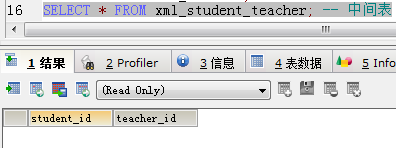

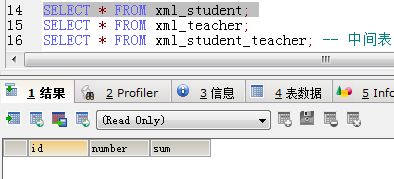

 表结构虽然看起来和单向多对多关联的没什么区别,但进行CRUD操作时,就会发现他们的区别了,此处不做解析
表结构虽然看起来和单向多对多关联的没什么区别,但进行CRUD操作时,就会发现他们的区别了,此处不做解析
Hibernate一对一单向关联映射(Annotation+XML实现):https://www.cnblogs.com/dshore123/p/11545058.html
Hibernate一对一双向关联映射(Annotation+XML实现):https://www.cnblogs.com/dshore123/p/11545077.html
Hibernate多对一单向关联映射(Annotation+XML实现):https://www.cnblogs.com/dshore123/p/11553213.html
Hibernate一对多单向关联映射(Annotation+XML实现):https://www.cnblogs.com/dshore123/p/11553215.html
Hibernate一对多和多对一双向关联映射(Annotation+XML实现):https://www.cnblogs.com/dshore123/p/11560433.html
Hibernate多对多单向关联映射(Annotation+XML实现):https://www.cnblogs.com/dshore123/p/11568536.html
Hibernate多对多双向关联映射(Annotation+XML实现):https://www.cnblogs.com/dshore123/p/11568963.html
|
原创作者:DSHORE 作者主页:http://www.cnblogs.com/dshore123/ 原文出自:https://www.cnblogs.com/dshore123/p/11568963.html 版权声明:欢迎转载,转载务必说明出处。(如果本文对您有帮助,可以点击一下右下角的 推荐,或评论,谢谢!) |
Java进阶知识12 Hibernate多对多双向关联(Annotation+XML实现)的更多相关文章
- Java进阶知识11 Hibernate多对多单向关联(Annotation+XML实现)
1.Annotation 注解版 1.1.应用场景(Student-Teacher):当学生知道有哪些老师教,但是老师不知道自己教哪些学生时,可用单向关联 1.2.创建Teacher类和Student ...
- Java进阶知识08 Hibernate多对一单向关联(Annotation+XML实现)
1.Annotation 注解版 1.1.在多的一方加外键 1.2.创建Customer类和Order类 package com.shore.model; import javax.persisten ...
- Java进阶知识09 Hibernate一对多单向关联(Annotation+XML实现)
1.Annotation 注解版 1.1.在一的一方加Set 1.2.创建Customer类和Order类 package com.shore.model; import java.util.Hash ...
- Java进阶知识05 Hibernate联合主键之Annotation(注解)和XML实现方式
1.Hibernate联合主键(Annotation实现) 1.1.单列主键 1.1.1.为什么要有主键? //唯一确定一条记录 1.1.2.一个表能否有多个主键? //不能 1.1.3. ...
- Java进阶知识10 Hibernate一对多_多对一双向关联(Annotation+XML实现)
本文知识点(目录): 1.Annotation 注解版(只是测试建表) 2.XML版 的实现(只是测试建表) 3.附录(Annotation 注解版CRUD操作)[注解版有个问题:插入值时 ...
- Java进阶知识07 Hibernate一对一双向外键关联(Annotation+XML实现)
1.Annotation 注解版 1.1.创建Husband类和Wife类 package com.shore.model; import javax.persistence.Entity; impo ...
- Java进阶知识06 Hibernate一对一单向外键关联(Annotation+XML实现)
1.Annotation 注解版 1.1.创建Husband类和Wife类 package com.shore.model; import javax.persistence.Entity; impo ...
- hibernate多对一双向关联
关联是类(类的实例)之间的关系,表示有意义和值得关注的连接. 本系列将介绍Hibernate中主要的几种关联映射 Hibernate一对一主键单向关联Hibernate一对一主键双向关联Hiberna ...
- Hibernate多对多双向关联的配置
Hibernate的双向多对多关联有两种配置方法:那我们就来看看两种方案是如何配置的. 一.创建以各自类为类型的集合来关联 1.首先我们要在两个实体类(雇员<Emploee>.工程< ...
随机推荐
- C程序设计语言练习 第三章
3.3 else-if语句 折半查找,这里通过一个折半查找说明三路判定程序的用法.该函数用于判定已排序好的数组v中是否存在某个特定的值.数组v的元素必须以升序排列.如果v中包含x,则该函数返回x在v中 ...
- Python 语言简介与入门
Python 的创始人为吉多·范罗苏姆(Guido van Rossum).1989年的圣诞节期间,吉多·范罗苏姆为了在阿姆斯特丹打发时间,决心开发一个新的脚本解释程序,作为ABC语言的一种继承.Py ...
- python 定时爬取内容并发送报告到指定邮箱
import requests import smtplib import schedule import time from bs4 import BeautifulSoup from email. ...
- Jmeter4.0---- jmeter中写入java代码_简单了解(15)
1.说明 BeanShell:是一个小型嵌入式Java源代码解释器,具有对象脚本语言特性,能够动态地执行标准JAVA语法,并利用在JavaScript和Perl中常见的的松散类型.命令.闭包等通用脚本 ...
- luogu1731生日蛋糕题解--恶心剪枝
题目链接 https://www.luogu.org/problemnew/show/P1731 分析 这题真[哔]恶心,加了一堆奇奇怪怪的优化 首先明确一点,半径和高都必须是正整数,意味着它们最小为 ...
- 关于spring中事务管理的几件小事
1.Spring中的事务管理 作为企业级应用程序框架,Spring在不同的事务管理API之上定义了一个抽象层.而应用程序开发人员不必了解底层的事务管理API,就可以使用Spring的事务管理机制. S ...
- 3.web开发入门知识
/*web入门*/ /*互联网上常用的协议以及它的端口*/ http 80 http://localhost/ 相当于 http://localhost:80/ http协 ...
- Azkaban无法启动错误Error: Could not find or load main class 12321
1 错误日志 Using Hadoop from /mnt/software/hadoop-2.6.0-cdh5.16.1 bin/internal/../.. /mnt/software/jdk1. ...
- [Abp vNext微服务实践] - 前后端分类
一.前景 abp vNext是ABP 开源 Web应用程序框架,是abp的新一代开源web框架.框架完美的集成.net core.identity server4等开源框架,适用于构建web应用程序和 ...
- Ubuntu系统---WeChat安装
Ubuntu安装微信教程 工具/原料 ubuntu 14.04 x86 方法/步骤 这次我用的系统是Ubuntu 14.04 x86,在网上先去下载electronic-wechat-linux ht ...
